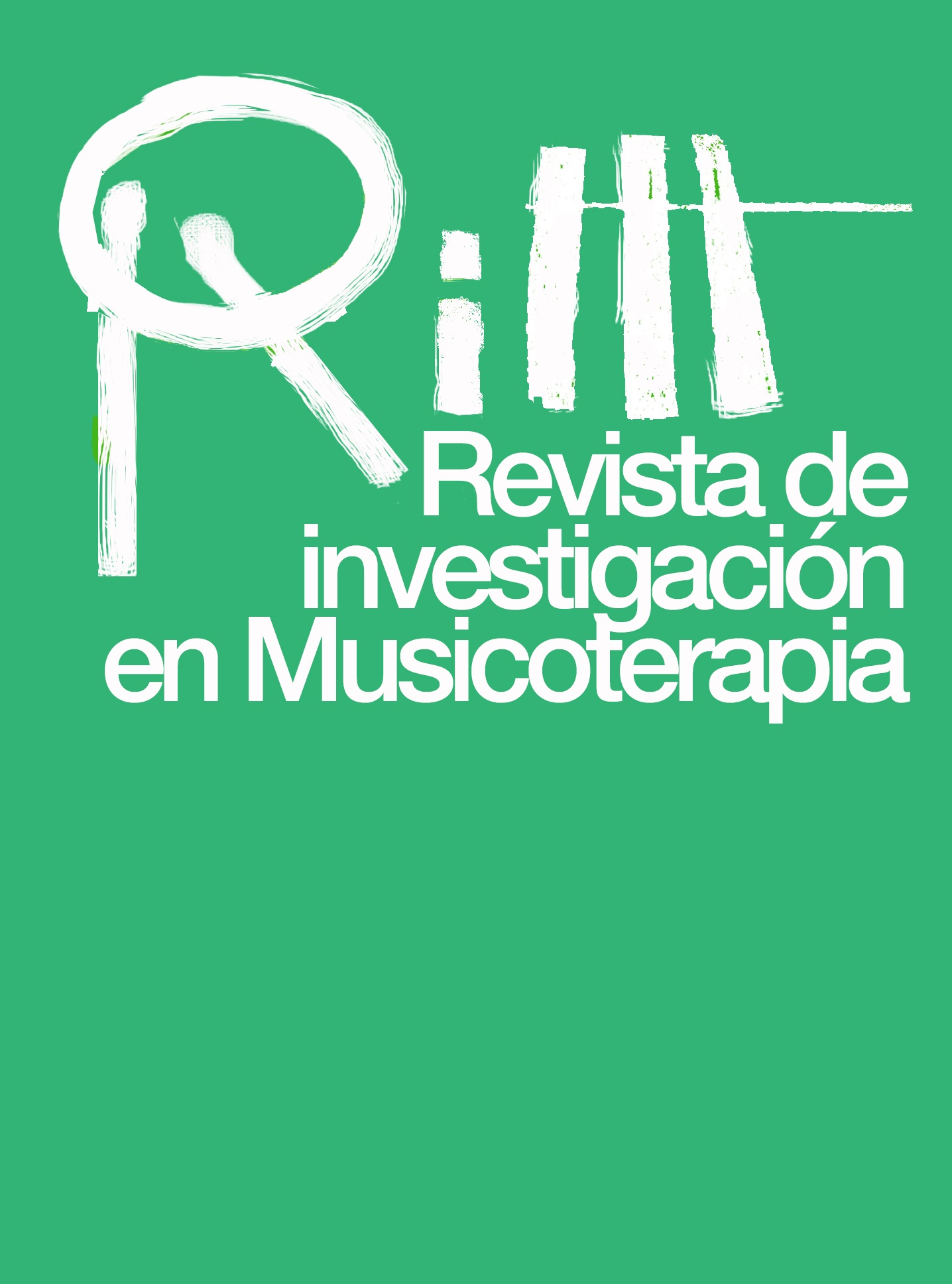Improvisation as a resource in music therapy. Single case study of a child enrolled in a TEA classroom
Keywords:
music therapy, adolescents, flow, humanistic music therapy, case-studyAbstract
Music therapy is a discipline with an important background that has demonstrated its substantial benefits for people with multiple different personal profiles. Humans at all stages of life, with functional diversity, health, cognitive, or emotional problems, can feel the benefits of music therapy. Adolescence is a convulse stage in human development, and music therapy can be an invaluable source of support so adolescents can develop in a positive way. Flow is, according to Csikszentmihalyi, an altered state of mind in which a person feels engaged with a gratifying activity, producing high levels of satisfaction. In the present research work, interactions between flow (Csikszentmihalyi, 2012) and music are explored through a case-study with one adolescent in a school context.
Downloads
References
Accordino, R., Comer, R., y Heller, W. B. (2007). Searching for music’s potential: A critical examination of research on music therapy with individuals with autism. Research in Autism Spectrum Disorders, 1, pp. 101–115.
Bruscia, K. (2010). Modelos de improvisación en musicoterapia. Vitoria: Editorial Agruparte. Chávez, S., y Barrena, F. (2012). Romper el silencio: musicoterapia aplicada al TEA. En M. Mercadal-Brotons, y P. Martí Augé. (Ed.), Música, musicoterapia y discapacidad (pp. 161-171). Ed. Médica Jims, S.L.
Dimitriadis, T., y Smeijsters, H. (2011). Autistic spectrum disorder and music therapy: theory underpinning practice. Nordic Journal of Music Therapy, 20(2), pp. 108- 122.
Drake, L., Ben-Yelun, F., y Del Olmo, M.J. (2017). Musicoterapia en una UCI pediátrica: El uso de la música como emergente emocional en el proceso de intervención con niños en situación de riesgo. Revista de Investigación en Musicoterapia, 1, pp. 14-31.
Gold, C., Wigram T., y Elefant C. (2007). Musicoterapia para el trastorno de espectro autista (Revisión Cochrane traducida). En: La Biblioteca Cochrane Plus, 2007 Número 4. Oxford: Update Software Ltd. Recuperado de http://www.update- software.com. (Traducida de The Cochrane Library, 2007 Issue 4. Chichester, UK: John Wiley & Sons, Ltd.).
Gold, C. (2011). Special section: music therapy for people with autistic spectrum disorder. Nordic Journal of Music Therapy, 20(2), pp. 105-107, DOI: 10.1080/08098131.2011.569164
Goldstein, C. (1964). Music and creative arts therapy for an autistic child. Journal of music therapy, 1, pp. 135-138.
Holck, U. (2004). Interaction Themes in Music Therapy: Definition and Delimitation.
Nordic Journal of Music Therapy, 13(1), pp. 3-19.
Kaplan, R., Steele, A. (2005). An Analysis of Music Therapy Program Goals and Outcomes for Clients with Diagnoses on the Autism Spectrum. Journal of Music Therapy; Spring 2005; 42(1), pp. 2-19.
Kaufmann, L., (2008). Las raíces intersubjetivas del autismo acerca de la resonancia empática entre un niño pequeño con signos clínicos de autismo y sus padres. Subjetividad y Procesos Cognitivos, 12, pp. 95-122. Universidad de Ciencias Empresariales y Sociales de Buenos Aires.
Kern, P., y Aldridge, D. (2006). Using embedded music therapy interventions to support outdoor play of young children with autism in an inclusive community-based child care program. Journal of Music Therapy, 43, pp. 270–294.
Kern, P., Wolery, M., y Aldridge, D. (2007). Use of songs to promote independence in morning greeting routines for young children with autism. Journal of Autism and Developmental Disorders, 37, pp. 1264–1271.
Kim, J., Wigram, T., y Gold, C. (2008). The effects of improvisational music therapy on joint attention behaviours in autistic children: A randomized controlled study. Journal of Autism and Developmental Disorders, 38, pp. 1758–1766.
Kim, J., Wigram, T., y Gold, C. (2009). Emotional, motivational and interpersonal responsiveness of children with autism in improvisational music therapy. Autism, 13, pp. 389–409.
Moreno, A., Rodríguez, C., y Del Olmo, M.J. (2017). Rhythmic ostensive gestures: How adults facilitate infants’ entrance into early triadic interactions. Infant Behavior and Development, 49, pp. 168–181.
Oldfield, A. (2016). The Future of Music Therapy for Persons with Autism Spectrum Disorder. En C. Dileo. (Ed.), Envisioning the Future of Music Therapy (pp. 96- 103). Temple University’s Arts and Quality of Life Research Center. OMS (2017). Recuperado de http://www.who.int/mediacentre/factsheets/autism- spectrum-disorders/es/ (1 de noviembre de 2017)
Pasiali, V. (2004). The use of prescriptive therapeutic songs in a homebased environment to promote social skills acquisition by children with autism: Three case studies. Music Therapy Perspectives, 20, pp. 11–20.
Pastó Serra, B. (2012). Musicoterapia y autismo infantil. En M. Mercadal-Brotons, y P. Martí Augé. (Ed.), Música, musicoterapia y discapacidad (pp. 173-181). Ed. Médica Jims, S.L.
Reschke-Hernández, A. (2011). History of Music Therapy Treatment Interventions for Children with Autism. Journal of Music Therapy, 48(2); pp. 169- 207.
Robbins, C., y Robbins, C. (1991). Self-Communications In Creative Music Therapy. En K. Bruscia. (Ed.), Case Studies in Music Therapy (pp. 55-72). Barcelona publishers.
Rose, P., y Johnson, K. (2014). The effects of structured musical activity sessions on the development of a child with autism spectrum disorder: A case study. Approaches: Music Therapy & Special Music Education, 6(2), pp. 88-98. Recuperado de http://approaches.primarymusic.gr
Simpson, K., y Keen, D. (2011). Music Interventions for Children with Autism: Narrative Review of the Literature. Journal of Autism and Developmental Disorders, 41; pp. 1507–1514. DOI 10.1007/s10803-010-1172-y
Tager-Flusberg, H., y Caronna, D. (2007). Language Disorders: Autism and Other Pervasive Developmental Disorders. Pediatric Clinics of North America, 54; pp. 469-481. doi:10.1016/j.pcl.2007.02.011
Trevarthen, C. (2002). Autism, sympathy of motives and music therapy. Enfance, 54(1) pp. 86-99.
Vaiouli, P. (2014). Joint engagement for toddlers at risk with autism: a family, music- therapy intervention. Music Therapy Perspectives, 32(2); p. 193.
Warnock, T. (2012). Vocal connections: How voicework in music therapy helped a young girl with severe learning disabilities and autism to engage in her learning. Approaches: Music Therapy & Special Music Education, 4(2), pp. 85-92. Recuperado de http://approaches.primarymusic.gr
White, B. (2015). ‘What sound can you make?’ A case study of a music therapy group for children with autism, learning disabilities and challenging behaviours. Approaches: An Interdisciplinary Journal of Music Therapy, 7(2), pp. 197-206.
Wigram, T. (1991). Music Therapy For A Girl With Rett's Syndrome: Balancing Structure and Freedom. En K. Bruscia. (Ed.), Case Studies in Music Therapy (pp. 39-53). Barcelona publishers.
